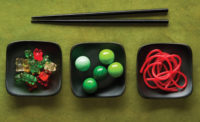They create the halo effect, demand premium prices and set trends — inclusions may just be the secret to the perfect chocolate.
And nuts are still the star of the show.
“Nuts are a classic inclusion, and to this day, they continue to be used in some of the most beloved chocolate confections, including turtles and clusters,” says Gretchen Hadden, marketing manager, Cargill Cocoa & Chocolate. “We see a plethora of nut types used across chocolate confectionery, including pecans, pistachios and peanuts. However, hazelnut and almond continue to be used most prominently across new product launches.”
Nuts also help create candymakers create more premium items, Hadden explains.
“Often, this is achieved by either pairing nuts with other sophisticated ingredients, such as sea salt or high cacao chocolate, or ‘romanticizing’ the process used on the nuts, be that chopped, toasted or roasted,” she says.
And consumers are willing to pay more for items that are perceived to offer premium ingredients. A recent Nielsen report found that one-quarter of global respondents were very willing to pay a premium for products that make specific health claims, such as all-natural or high-protein, says Jeff Smith, director of marketing, Blue Diamond Almonds Global Ingredients Division.
And almonds specifically have maintained their premium status over the years.
“Due to their versatility and many nutritional benefits, almonds are well-established as a premium inclusion, finding popularity in sweet treats around the world. Whether used as a coating, topping or within a nut-filled center, almonds can help augment texture, crunch, flavor, visual appeal and nutritional content for a variety of confectionery formulations,” Smith says.
Inclusions can also help create contrast — between both flavors and textures.
“The juxtaposition of sweet and savory continues to be a popular inclusion trend, as consumers seek new and original flavor experiences,” Smith says. “Mouthfeel has also been shown to play an important role in consumers’ shopping decisions, and manufacturers are experimenting with contrasting textures in their candy and confection formulations.”
For example, a hard and crunchy inclusion like almonds can complement softer textures, such as that of fudge or other chewy candies, he adds.
The bean-to-bar chocolate movement also has paved the way for creativity through inclusions, with seemingly nothing off limits, Hadden says.
“Beyond nuts, chocolatiers are exploring a variety of creative approaches using inclusions to deliver a crunchy experience, including pretzel pieces and bread crumbs,” she says. “We’re seeing inclusions used to create an artisan, rustic aesthetic such as chocolate bars studded perfectly imperfect with cocoa nibs, dried fruit and espresso beans, or dusted with spices, sea salt and more.”
Inclusions also are being used to create more enticing seasonal offerings — ranging from crunchy peppermint inclusions during the holidays and s’mores during the summertime.
“Chocolatiers are truly artists, and inclusions have become an exciting tool to deliver endless creativity,” Hadden says.
How to add inclusions to chocolates
But how should chocolatiers go about actually adding the inclusions?
The flavor profile and intensity of an inclusion are the first thing to consider, and they can help candy makers choose the right chocolate or compound coating.
“For example, if a center is a subtle fruit flavor, perhaps a milk chocolate coating or lower cacao coating may work best so as not to overpower the flavor of the inclusion,” says Thomas Jablonowski, senior technical services manager, Cargill Cocoa & Chocolate. “Conversely, if the center has a strong flavor such as mint, it may be able to handle a more robust flavored coating, such as a high cacao dark chocolate.”
The next issue is maintaining the integrity of the inclusion’s flavor and texture in the candy. For this, it’s important to consider the type of inclusion being used and the filling.
“For example, if you are using a water-based center with a dry, crispy, starch-based inclusion, coat the inclusion with a water barrier to maintain its crispiness,” Jablonowski says. “This prevents the inclusion from becoming soft due to water migration from other ingredients in the product.”
Another issue that comes up is preventing fat migration when adding inclusions.
“Colder temperatures slow fat migration, so proper storage and temperature control during shipping and handling is important,” Jablonowski says. “In addition, a thicker layer of chocolate or compound coating can provide more of barrier to migration than a thinner layer. In some instances, double coatings are used.”
Other tips to prevent fat migration are related to the inclusions themselves.
“In some instances, you might consider a barrier coating around the inclusion, such as a compound coating. If the inclusions are coated in a barrier first that can slow fat migration,” Jablonowski says. “Also, consider minimizing the oil content in the inclusions. For example, if working with nut inclusions, you could use dry-roasted nuts instead of oil-roasted nuts.”
Chocolate viscosity, which measures the thickness and flow of liquid chocolate, is another consideration when moulding or enrobing chocolate or compound confections. A higher viscosity chocolate will be thicker in liquid form, whereas a lower viscosity chocolate will be thinner and have more flowability.
“You should select chocolate with a viscosity that is adequate to fully coat the piece, including any edges or crevices that may be caused by inclusions,” Jablonowski says. “If you are aiming to create an indulgent chocolate turtle or cluster, a medium thickness viscosity chocolate is often best. Conversely, if you are seeking to create a truffle with a thin shell and opt for a lower viscosity to achieve this, be sure to consider the possibility of oil migration and corresponding specifications such as shelf life.”
When candy makers get it just right, though, the results are worth the work.





